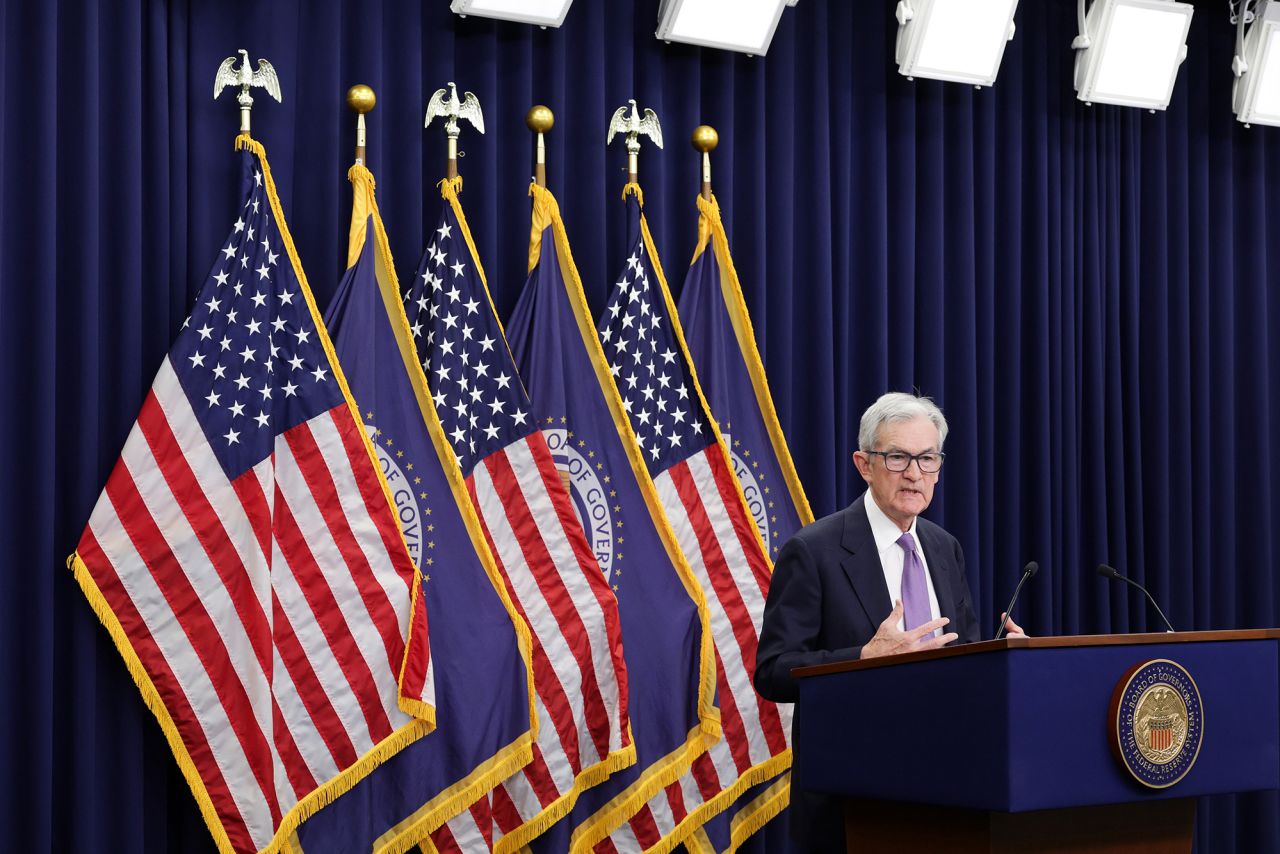What we covered here
• The Federal Reserve said Wednesday it is lowering its benchmark interest rate by a quarter point, but offered no clear outlook for its next decision, due in December.
• Central bank officials have been forced to make the latest monetary policy determinations without key federal economic data, including inflation and jobs reports, due to the government shutdown.
• If the data blackout persists for much longer — obscuring how the world’s largest economy is faring — central bankers may need to hold off on any rate cuts until there’s better clarity.
Our live coverage of the October Federal Reserve policy meeting has ended. Read more here.
That's a wrap
Federal Reserve officials voted for another quarter-point rate cut on Wednesday, lowering their benchmark lending rate to a range between 3.75% and 4%, the lowest in three years.
The decision drew two dissents; one from Fed Governor Stephen Miran, who backed a larger, half-point cut; and another from Kansas City Fed President Jeffrey Schmid, who preferred to hold borrowing costs steady.
It is the first time since 2019 that there were dueling dissents — both calling for easier and tighter policy — underscoring the heated debate among officials over how President Donald Trump’s sweeping policies on trade, immigration and spending are affecting the US economy.
To make matters more complicated, it was also the first time officials have set monetary policy while lacking an entire month of crucial government employment figures in the modern era.
For additional takeaways on today’s decision, read more here.
Stocks closed mixed as Powell says December rate cut far from "foregone conclusion"

US stocks closed mixed on Wednesday after Federal Reserve Chair Jerome Powell said the central bank’s interest rate policy is not on “preset course,” and an additional rate cut in December is not guaranteed.
The Dow closed lower by 74 points, or 0.16%. The S&P 500 closed flat. Meanwhile, the tech-heavy Nasdaq Composite eked out a gain of 0.55% and closed at a record high.
The Dow and S&P had clinched intraday record highs earlier before turning lower in the afternoon. The Fed lowered its benchmark interest by a quarter point, as expected. Yet Powell said further policy decisions are not certain.
“A further reduction in the policy rate at the December meeting is not a foregone conclusion. Far from it,” Powell said. “Policy is not on a preset course.”
“We haven’t made a decision about December, and you know, we’re going to be looking at the data that we have, how that affects the outlook and the balance of risks,” Powell said.
In the bond market, Treasury yields rose as investors adjusted their expectations for inflation and the Fed’s interest rate policy. The 10-year yield climbed to 4.07% after trading at 3.98% earlier.
“Given the potential contentious tone behind the scenes when it comes to a December decision, it will be telling to keep an eye out as the quiet period is now over and the committee members make the speaking rounds,” Jay Woods, chief market strategist at Freedom Capital Markets, said in an email.
Money moves to make now that the Fed has cut rates again

The Federal Reserve’s move on Wednesday will affect various consumer savings and lending rates throughout the economy.
It could make it a little harder — but still possible — to find attractive, inflation-beating yields for your savings if you comparison shop. Even if the rates available today move down a bit given the Fed’s latest move, there are still plenty of low-risk options that let you grow your savings and protect your purchasing power.
If you have debt, the Fed’s moves may save you some money. But how much debt you choose to take on, how quickly you plan to pay it off and how high you can get your credit score before applying for a loan may save you more money than a small rate cut or two from the Fed.
Read more here.
Here's what Wall Street is saying about the Fed rate cut

The Federal Reserve cut its benchmark interest rate by a quarter point, matching Wall Street’s expectations. Now, the questions turns to whether the central bank will cut again in December.
Stocks have rallied in recent months on optimism about Fed rate cuts. While those cuts are in response to a weakening labor market, lower borrowing costs can be a boon for stocks.
Here’s what investors and economists are saying:
- “[Fed Governor Jeffrey Schmid’s] dissent in favor of no change was unexpected.” — Lon Erickson, portfolio manager at Thornburg Investment Management. “In hindsight, however, last month’s [Summary of Economic Projections] showed seven people favored one or no rate changes from September to December.”
- “There are strongly differing views on the Fed, and there are a lot of question marks about how to proceed in December. That was a bit unnerving for markets to hear.” — Kristina Hooper, chief market strategist at Man Group. “But let’s face it, we knew that looking at the dot plot in September, and we also could assume that would happen, just based on the scarcity of data. It’s going to be harder to come to a consensus when there isn’t much in the way of available recent data.”
- “A softening labor market and the risk of tariff-induced inflation leave no clear playbook to follow, but for now the path of least resistance appears to be easier policy.” — Jason Pride, chief of investment strategy and research at Glenmede.
- “We see another cut in December and two more next year.” — Scott Wren, senior global market strategist at Wells Fargo Investment Institute. “We see the inflation rate moderating somewhat next year.”
- “As the shutdown drags on and critical economic data remains unavailable, the challenge of making informed monetary policy choices will only grow — especially if the disruption continues into November.” — Stephen Kates, financial analyst at Bankrate.
Powell isn't concerned by all the AI companies fueling stock market gains

With Nvidia reaching a market cap of $5 trillion and several other AI companies fueling overall market gains — and supporting the economy through consumer spending — many are starting to wonder if there’s a growing asset bubble akin to the 1990s.
Federal Reserve Chair Jerome Powell isn’t too worried, though.
“This is different in the sense the companies so highly valued actually have earnings and stuff like that,” he said Wednesday, referring to the dot-com bubble. “These were ideas rather than companies. There was a clear bubble there.”
Generally, AI-centric companies “have earnings, and it looks like they have business models and profit and that kind of thing, so it is really a different thing” from when the dot-com bubble popped, he said.
Powell says the Fed is watching corporate layoffs stemming from AI advancements "really carefully"
Federal Reserve Chair Jerome Powell said Wednesday a recent string of mass corporate layoff announcements coming in part because of advancements in artificial intelligence is something central bankers are watching “really carefully.”
Among the biggest announcements was Amazon, which laid off 14,000 workers this week as it readies the company for wider adoption of AI technology. In addition to contributing to layoffs, Powell said that AI “could absolutely have implications for job creation.”
Inflation is still "very much" making consumers unhappy, Powell says

President Donald Trump’s tariffs are having a “fairly modest” impact on overall inflation, Federal Reserve Chair Jerome Powell said Wednesday at a press conference. But consumers are still feeling it.
Tariffs raise costs through a one-time price increase, he said, noting that prices “stop going up” once the last tariff is applied.
However, as Powell noted, US consumers don’t differentiate between the reasons behind higher prices, and are already weary from the inflation of the pandemic years.
“Consumers are not interested in that story,” he said. “More than that, the reason they are so unhappy about inflation is the inflation we had in 2021, 2022 and 2023. You can say prices aren’t going up as much, but that doesn’t mean that people aren’t feeling those higher prices from the inflation we had two or three years ago. They are, and that is why for a large part of the public, inflation is still very much making people unhappy.”
Treasury yields rise as Powell tempers hopes for further rate cuts

Bond prices fell, pushing yields higher, as Federal Reserve Chair Jerome Powell tempered hopes for an additional rate cut in December.
“A further reduction in the policy rate at the December meeting is not a foregone conclusion. Far from it,” Powell said. “Policy is not on a preset course.”
The 10-year Treasury yield rose to 4.05% after trading at 3.98% earlier in the day. The two-year yield jumped to 3.58% after trading at 3.5% earlier. Treasury yields rise as investors sell bonds.
“Looking ahead, we anticipate a bit less easing from the Fed than the market is currently priced for over the next year alongside an uptick in inflation expectations, which will likely push 10-year rates up,” Jeffrey Palma, head of multi-asset solutions at Cohen & Steers, said in an email.
The US dollar index, which measures the dollar’s strength against six major foreign currencies, rose 0.6%. The rise in Treasury yields and the dollar reflect expectations for stubborn inflation and the adjusted view that the Fed is not locked in to a rate cut in December.
Meanwhile, stocks wavered. The Dow was down 50 points, or 0.1%. The broader S&P 500 fell 0.07%. The tech-heavy Nasdaq Composite was up 0.35% after briefly dipping into the red.
Stocks fall as Powell says Fed officials have "strongly differing views" on a December cut
While most Federal Reserve officials converged around a quarter-point cut at this month’s monetary policy meeting, Federal Reserve Chair Jerome Powell said Wednesday that officials are already beefing about what to do at the next monetary policy.
“There were strongly differing views about how to proceed in December,” he said at his post-meeting press conference, while stressing that no decisions have been made.
“I always say that. It is a fact that we don’t make (advanced) decisions, but I am saying something in addition here: That it is not to be seen as a foregone conclusion. In fact, far from it.”
The Dow and S&P 500 dipped into the red after Powell’s comment. The Dow fell by more than 200 points, or 0.45%. The broader S&P 500 fell 0.5%. The tech-heavy Nasdaq Composite fell 0.2%.
Dueling dissents were cast

While the majority of Federal Reserve officials voted Wednesday to lower interest rates by a quarter point, two central bankers cast different dissenting votes.
Fed Governor Stephen Miran, a second-term Trump appointee who joined the Fed just last month, voted for a half-point cut, marking his second dissenting vote in a row.
Kansas City Fed President Jeffrey Schmid, meanwhile, voted to hold rates steady.
The Fed will stop shrinking its balance sheet

In a separate decision, policymakers announced the end of a three-year process to shrink the size of their enormous portfolio by December 1.
The Fed’s portfolio, or balance sheet, reached about $9 trillion in mid-2022, but is now around $6.6 trillion after a careful effort to reverse the stimulus it introduced into the economy during the Great Recession and the Covid-19 pandemic.
It’s a tool that works in the background while the Fed’s key interest rate does much of the heavy lifting to achieve its macroeconomic goals. Officials have judged that the balance sheet is close to a more normal state.
Stocks are modestly higher as Fed cuts rates

US stocks were higher Wednesday afternoon after the Federal Reserve cut its benchmark interest rate by a quarter point, matching Wall Street’s expectations.
The Dow was up 121 points, or 0.25%. The S&P 500 was up 0.15%, and the tech-heavy Nasdaq was up 0.5%. The indexes were off their highest levels of the day but still on track to close at record highs.
“Uncertainty about the economic outlook remains elevated,” the Fed said in a statement. “The Committee is attentive to the risks to both sides of its dual mandate and judges that downside risks to employment rose in recent months.”
Traders’ attention now turns to Federal Reserve Chair Jerome Powell’s press conference, slated for 2:30 p.m. ET.
Investors are also focused elsewhere: Big Tech earnings are slated for this afternoon, while President Donald Trump and Chinese leader Xi Jinping are scheduled to meet later in South Korea.
“We’re in arguably the most pivotal stretch for markets … as the events over the next week will likely set the tone into year end,” Garrett Melson, portfolio strategist at Natixis Investment Managers, said in an email.
“By the close of the week investors will have incremental clarity on the three biggest themes in markets: Fed policy, the AI boom and US-China trade relations,” Melson said.
Treasury yields ticked up heading into the decision. The two-year yield traded at 3.52% and the 10-year yield traded around 4.01%.
Fed cuts interest rates for the second time this year

The Federal Reserve on Wednesday lowered interest rates for the second time this year in a continued bid to prevent unemployment from surging.
Fed officials voted for another quarter-point rate cut, lowering their benchmark lending rate to a range between 3.75% and 4%, the lowest in three years.
It is the first time since the Fed’s rate-setting committee was established in the 1930s that officials have set monetary policy while lacking an entire month of crucial government employment data due to a government shutdown.
Sen. Warren raises concerns about Fed not having sufficient data due to government shutdown

Democratic Sen. Elizabeth Warren is concerned that the lack of government data being produced due to the ongoing shutdown is making it harder for the Federal Reserve to make the best decisions about where interest rates should be.
“I think that it is right for the Fed to cut rates, but getting that done accurately, knowing how much they should cut, depends on data,” Warren told reporters on Wednesday, ahead of the Fed’s decision. “The whole point of an independent Fed is that they look through the numbers, you know, they’re boring nerds, and then they make their best decision for the economy.”
She went on to blame President Donald Trump for the shutdown, which, among other issues, has paused the release of government-produced economic data.
“And I don’t say it’s bad for Democrats. I say it is bad for everyone, Democrats, Republicans, independents, everyone. This is a really bad move,” Warren, the ranking member of the Senate Banking Committee, said.
Stocks rise ahead of tech earnings as Nvidia hits $5 trillion valuation

Enthusiasm about AI has lifted the market higher this year. The rally increasingly relies on the fate of a few enormous tech companies.
Wall Street this afternoon will be focused on quarterly earnings reports from Alphabet (GOOG), Microsoft (MSFT) and Meta (META). Investors will turn to results from Apple (AAPL) and Amazon (AMZN) on Thursday.
Those five companies —- in addition to Nvidia (NVDA) and Tesla (TSLA) — have accounted for roughly 46% of the S&P 500’s gains this year, according to Howard Silverblatt, senior index analyst at S&P Dow Jones Indices.
Nvidia shares are up 54% this year, leading the group higher. Alphabet shares are up roughly 43%.
“They’ve gone up so much,” said Peter Ricchiuti, senior professor of finance at Tulane University. “They’re very ripe for disappointment.”
US stocks were higher Wednesday afternoon as traders awaited the Federal Reserve’s decision on interest rates. The Dow was up 132 points, or 0.28%. The S&P 500 rose 0.17%, and the tech-heavy Nasdaq Composite rose 0.53%.
“This week’s big tech earnings may be the most important in recent memory since many investors are skeptical about the stock market’s rally over the past two months,” David Laut, CEO at KERUX Financial, said in an email.
Supreme Court won't be hearing arguments this year on whether Trump can fire Fed Governor Lisa Cook

Heading into last month’s monetary policy meeting, it was unclear if Federal Reserve Governor Lisa Cook would be able to cast her vote after President Donald Trump attempted to fire her.
Right before the two-day meeting kicked off, an appeals court ruled Trump didn’t have the authority to fire her, paving the way for her to participate in the meeting.
Then earlier this month, the Supreme Court announced it would hear arguments in the case that will largely determine the degree to which the central bank can function independently from politicians. The nation’s highest court won’t begin to hear arguments until January, giving Cook the ability to continue working at the Fed, at a minimum, until then.
Cook is set to deliver an address at the Brookings Institution next week on the economic outlook, her first public speech since she was accused of mortgage fraud by the Trump administration, which has not provided any evidence of wrongdoing.
Here's what one Fed official had to say about the lack of key economic data

Almost every Federal Reserve official will tell you that they follow a data-dependent approach for making interest rate decisions. That means if recent job reports show the labor market has weakened, officials may be more inclined to cut. Or if it shows inflation has been accelerating, they may opt to hike.
But because of the ongoing government shutdown, there’s a huge void of data that could otherwise have helped officials make a more optimal interest rate decision at this month’s monetary policy meeting.
Fed Governor Christopher Waller said in a speech earlier this month there’s a “conflict right now between data showing solid growth in economic activity and data showing a softening labor market.” Because of that conflict, he said officials need to be more careful when deciding their next interest rate move.
He added:
Waller also said he’s been relying more on the anecdotal data he gathers from interviewing businesses to help him determine the current state of the economy.
A landmark Supreme Court case on tariffs kicks off next week. The ruling could change the Fed's calculus

The fate of the majority of President Donald Trump’s tariffs hinges on a Supreme Court case that kicks off next week.
The justices will consider whether Trump had the legal authority to impose tariffs across virtually all goods the US imports by citing emergency powers.
No matter the outcome of that case, Trump will continue to have plenty of levers to impose tariffs. But if the court rules against him, it would undo many tariffs currently in place and also prevent Trump from being able to impose new ones as quickly as he has.
If that happens, it may be a big relief for Fed officials because it could give them more of an ability to continue cutting rates to help juice the labor market without giving as much consideration to whether it’ll simultaneously fuel more inflation.
Who’s who on Trump's short list for the next Fed chair

The Trump administration’s search for who will lead the Federal Reserve next year is well underway, and there are five people on the short list to become the most powerful figure in the US economy.
Few people wield as much influence over financial markets and the global economy as the head of the US central bank. A few words from the Fed chair can move markets and shift billions of dollars.
It’s a role so consequential that President Donald Trump has even mused about taking it for himself.
Trump is expected to name his pick for a replacement as soon as December. That would be the earliest any president has announced a Fed chair nominee before the incumbent steps down.
Treasury Secretary Scott Bessent, who is leading the administration’s search, said Monday he has narrowed it down to five people. Their backgrounds include the White House, the Fed, and the private sector.
Read more here.







